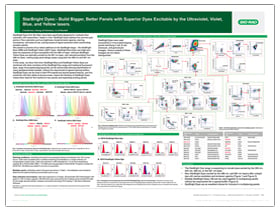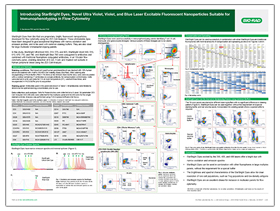StarBright Dyes Posters
Improving and Expanding Immunophenotyping Panels with StarBright Dyes
Presented at AAI 2023, the features of StarBright™ Dyes, are highlighted using data acquired on the ZE5 Cell Analyzer. Additionally, a 38-color human immunophenotyping panel demonstrates that using antibodies conjugated to StarBright Blue and StarBright Yellow Dyes can expand panel size in spectral flow cytometry.
View Downloadable Posters

StarBright Dyes – Making Panel Design Easier for Everyone
The benefits of using StarBright Dyes for multiplexing are highlighted, such as narrow excitation and emission profiles and premixing.

Expanding the Size of Multicolor Panels with Ease with New StarBright Blue and StarBright Yellow Dyes
38-color spectral panel, with a low complexity score, using StarBright Dyes on a 5-laser spectral flow cytometer.
Improving Flow Cytometry Assays with StarBright Dyes
Several posters presented at CYTO 2023 demonstrate the benefits of antibodies conjugated to the StarBright Dye range in several flow cytometry applications. These include large immunophenotyping panels, identifying rare cell populations, and using tetramers to detect antigen-specific T cells.
View Downloadable Posters

StarBright Dyes: Improved Panel Design with New StarBright Blue, StarBright Yellow, and StarBright Red Dyes
A 27-color panel on the ZE5 Cell Analyzer demonstrates the use of the StarBright Dye range in a panel without the need for a special buffer. The benefits of using StarBright Yellow Dyes compared to PE-tandem dyes for multiplexing is also highlighted.

StarBright Dyes: Expanding the Size of Multicolor Spectral Panels with Superior Dyes Excitable by the UltraViolet, Violet, Blue, Yellow, and Red Lasers
StarBright Dyes are ideal for use in spectral flow cytometry as shown in a large 43-color panel with a low complexity score. Unique spectral profiles of StarBright Yellow and StarBright Red Dyes enable the use of novel fluorophore combinations.

Rare Cell Population Detection with StarBright Dye Antibody Conjugates
StarBright Dyes are bright, stable, and consistent making them a superior choice to detect and characterize rare cell populations, such as hematopoietic stem cells.

StarBright Red Dyes: Superior Dyes for Flow Cytometry
New StarBright Red Dyes are ideal for conventional and spectral flow cytometry. In addition, StarBright Dyes bound to tetramers via streptavidin can be used to identify antigen-specific T cells.

Spectral Unmixing to Substract Autofluoroscence in Samples Collected with the ZE5 Cell Analyzer
Spectral unmixing analysis and autofluorescence removal can improve population resolution over traditional compensation. For example, when studying pHrodo Green phagocytosis in J774 cells in combination with surface staining using StarBright Dye conjugated antibodies.
Expanding Immunophenotyping Panel Size with StarBright Blue and Yellow Dyes
Presented at CYTO 2022, these 21-color and 31-color, human immunophenotyping panels, showcase how the new StarBright Blue and StarBright Yellow Dyes can be used to expand both dye choice and panel size in immunophenotyping. Useful as a reference when building your own panels, see how these posters featuring StarBright Dyes in both conventional and multicolor flow cytometry. Featuring data obtained using StarBright Dyes and the ZE5 Cell Analyzer and StarBright Dyes and a spectral flow cytometer, respectively.
View Downloadable Posters

Expanding Panel Size in Spectral Flow Cytometry with StarBright Dyes Excitable by the UltraViolet, Violet, and Blue Lasers
31-color spectral panel built using StarBright Dyes and a 4-laser spectral flow cytometer.

StarBright Dyes: Build Bigger, Better Panels With Superior Dyes Excitable by the UltraViolet, Violet, Blue, and Yellow Lasers
21-color panel built using only antibodies from Bio-Rad and the ZE5 Cell Analyzer.
StarBright Violet, UltraViolet, Blue, and Yellow Dyes: Novel, Bright Fluorescent Dyes with Superior Capability
Presented at AAI 2022, these human immunophenotyping panels, showcase how StarBright Dyes can be used to expand panel size in multicolor immunophenotyping panels. Useful as a reference when building your own panels, see how these posters featuring StarBright Dyes and the ZE5 Cell Analyzer can help you build bigger better panels.
View Downloadable Posters

StarBright Dyes – Build Bigger, Better Panels with Superior Violet and Ultraviolet Laser Excitable Dyes
Poster comparing the stain index of StarBright Dyes to dyes from other vendors, and the effect of pre-mixing antibody cocktails containing StarBright Violet and UltraViolet Dyes compared to freshly made up cocktails.

StarBright Dyes:- Build Bigger, Better Panels With Superior Dyes Excitable by the Blue and Yellow Lasers.
11-color panels introducing StarBright Blue and StarBright Yellow Dyes on the ZE5 Cell Analyzer.
High-Parameter Immunophenotyping Panels Featuring StarBright Dyes
Presented at CYTO 2021, these 18-color and 27-color, human immunophenotyping panels, generated using StarBright Dyes and the ZE5 Cell Analyzer and a spectral flow cytometer respectively, highlight how to build successful panels while showcasing the properties and benefits of StarBright Dyes in large multicolor panel experiments.
Perfect as a reference when building your own panels.
View Downloadable Posters

The Use of New StarBright Dyes in Spectral Flow Cytometry
27-color spectral panel built using StarBright Dyes and a spectral flow cytometer.

Introducing StarBright Dyes, Novel Ultra Violet, Violet, and Blue Laser Excitable Fluorescent Nanoparticles Suitable for Immunophenotyping in Flow Cytometry
18-color panel built using StarBright Dyes and the ZE5 Cell Analyzer.
StarBright Violet Dyes, Novel, Bright Fluorescent Nanoparticles Suitable for Flow Cytometry
Presented at AAI 2021, the two posters below highlight the incredible performance of StarBright Violet Dyes in conventional and spectral flow cytometry. These exceptionally bright dyes, with improved spectral properties, have better performance in multicolor panels and require no special buffer, compared to competitor dyes. Furthermore, they are photostable, fixable, and can be premixed for up to 28 days. Their unique spectra allow the use of novel dye combinations.
View Downloadable Posters

StarBright Dyes — New Tools for Flow Cytometry
The benefits of StarBright Dyes are highlighted in conventional and full spectrum flow cytometry.

Novel, Violet Fluorescent Nanoparticles for Immunophenotyping Using Flow Cytometry
Comparison of StarBright Dyes in multicolor immunophenotyping without the use of special buffers.



